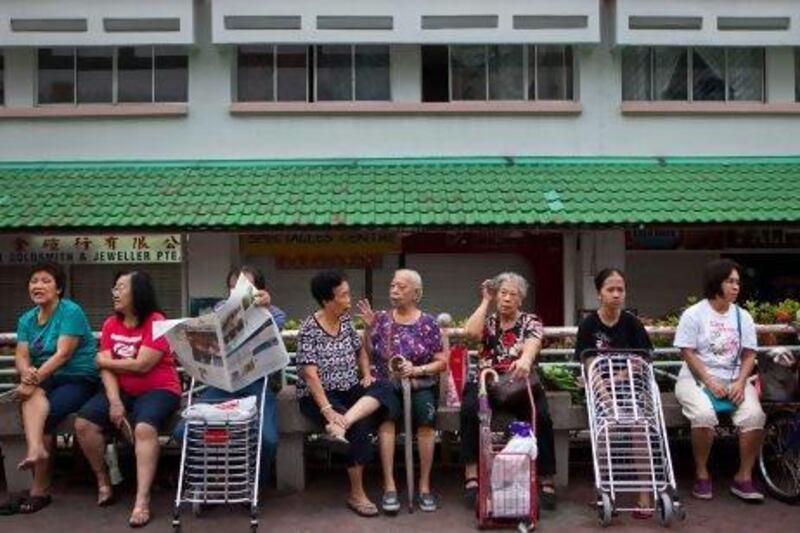SINGAPORE // Once upon a time in a land far, far away in the middle of Asia, the young people were too busy working and making money to have babies.
So their government started telling the Singaporeans fairy tales to encourage them to marry and start families before it was too late.
Singapore is one of the world's richest countries, but it faces a population crisis.
The government's new take on classic fairy tales and nursery rhymes, such as Snow White and Humpty Dumpty, are just the latest social engineering initiative to try to boost the birth rate so the country can maintain its position as a vital financial and trading hub.
Snow White comes with the advice that if a husband and wife are intimate two to three times a week, it greatly increases the possibility of conception during ovulation.
The Golden Goose, in which the goose can no longer lay eggs because her "egg-making device was rusty and old", warns of the problem of infertility as women age.
The fairy tales are online and have been distributed to universities in leaflets. "I just laughed," says Lee Bin Hua, 20, an international relations student. "A husband and a family is not even on my radar. I need a career first."
In the past Singapore has tried government-sponsored speed dating and published cartoons on how to date and advice on how to flirt.
Controversially, the government recently adopted a policy paper - A Sustainable Population for a Dynamic Singapore - calling for a large increase in the number of foreigners to be granted citizenship.
The move sparked a rare protest last month, with more than 4000 demonstrators complaining the country's identity would be lost in a sea of foreign faces. It was one of the biggest political protests since independence in 1965.
The policy paper, prepared by the National Population and Talent Division of the prime minister's office, sets out a road map for dealing with an ageing population. Put simply, Singapore needs more young people to pay for its ageing baby boomers.
"We are producing too few babies, our society is ageing, and if we do nothing our population will soon start shrinking," Singapore's prime minister, Lee Hsien Loong, said recently.
"Singapore must continue to develop and upgrade to remain a key node in the network of global cities, a vibrant place where jobs and opportunities are created."
Singapore has 5.3 million people. The government wants to boost that to 6.9 million by 2030. But Singaporeans are too busy working some of the longest hours in the world to plan for families, or they leave it until they are over 40, when fertility drops 95 per cent.
While the policy paper calls for maintaining a "Singaporean core", the increase in foreigners granted citizenship and permanent residence would see native Singaporeans fall to half the population in the next 17 years.
As well as the public outcry, the new policy has sparked criticism from economists and intense parliamentary debate.
Despite covering about half the area of Greater London, Singapore - the poorest member of the Malaysian federation before it was forced out in 1965 - is an economic powerhouse and also punches above its weight diplomatically.
Its port is the world's busiest after Shanghai. Although ranked the easiest place to do business for seven straight years by the World Bank, Singapore is competing with lower-cost neighbours such as Malaysia, Indonesia and Thailand for foreign investment.
Without resources of its own, Singapore relies on the outside for almost everything - even its drinking water is piped in from Malaysia.
It relies on its economic clout to give it weight on the world stage and maintain its standard of living.
But it is an expensive place to live and many Singaporeans blame foreign workers for rising costs, as well as the increasing strains on the country's infrastructure.
In a city with 3.3 million citizens and 2 million foreigners, complaints about overseas workers helped opposition parties win record support in the 2011 general election.
Mr Lee is under pressure to placate voters without disrupting the entry of talent and labour that helped forge South East Asia's only advanced economy.
In a country more densely populated than Hong Kong, housing prices are so high that many young working couples have to live with their parents for years until they can afford an apartment.
In response to the government's plans and the public outcry, the opposition Workers Party introduced its own policy paper: A Dynamic Population for a Sustainable Singapore.
It called for the labour shortage to be addressed by tapping women and older Singaporeans instead of bringing in foreigners. It also urged a maximum population of 5.8 million by 2030.
Ina Jufri, 31, a sales executive, encapsulates the dilemma Singaporeans face.
"There are too many foreigners. We are losing our identity," she says.
"[But] I don't have time for a family."
[ foreign.desk@thenational.ae ]
* The fairy tales are available on the website thesingaporeanfairytale.com
twitter: For breaking news from the Gulf, the Middle East and around the globe follow The National World. Follow us





